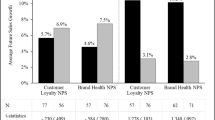Abstract
Demand models produce biased results when applied to data aggregated across stores with heterogeneous promotional activity. We show how to modify extant aggregate demand frameworks to avoid this problem. First a consumer-level model is developed, which is then integrated over the heterogeneous stores to arrive at aggregate demand. Our approach is highly practical since it requires only standard scanner data of the type produced by the major vendors. Using data for super-premium ice cream, we apply the proposed methodology to the random coefficients logit demand framework.

Similar content being viewed by others
Notes
A confidentiality agreement with ACNielsen prohibits retailer names from being revealed. This example does not indicate whether the dataset employed contains the Jewel supermarket chain in Chicago.
Boatwright et al. (2004) is a recent example that uses this methodology to avoid aggregation bias.
In addition, UPCs vary by package size. Most brands of super-premium ice cream are available only in pint-sized containers, however, with larger package sizes representing a small fraction of category sales. We therefore omit them from the analysis by restricting the dataset to pint-sized cartons.
City-chain subscripts are dropped from the control variables for ease of notation.
Following Train (1999), we discard the first 10 elements of the Halton sequence since early elements tend to be correlated. Therefore, we generate a sequence of 1,010 elements, rather than 1,000.
In the representative store model we drop the i subscript from X ijt since the included variables are identical across all consumers.
It is unclear whether “Display Only” or “Feature Only” is higher ranked. We obtain similar results when we let “Display Only” outrank “Feature Only.”
Parameter ρ does not vary over time and is identical across retailers. We make this simplifying assumption since only 15% of the dataset's observations identify the joint promotional distribution. A more flexible specification can be employed in situations where it is practical to do so.
A second advantage is that including the error term within the utility function facilitates use of instrumental variables. This is not an issue here since we lack valid instruments. Supplemental material available upon request details the reasons why valid instruments do not exist for this product category.
We calculate the variance matrix of the parameter estimates using the standard GMM formulas, where the first order conditions from the log-likelihood function are used as moment conditions. Refer to Hamilton (1994) for discussion of this “quasi maximum likelihood” approach of obtaining robust standard errors.
We also considered the following alternative framework. We let \( \{ \pi _t^g \} _{g \in G} \) be a weighted average of two distributions: the distribution that arises when ρ=0 and the distribution when ρ=1. Using this specification, we obtain the same joint distribution as before, where each brand's promotions are positively correlated to the maximum possible extent.
References
Ackerberg, D. A. & Rysman, M. (2005). Unobserved product differentiation in discrete choice models: Estimating price elasticities and welfare effects. RAND Journal of Economics, 771–788.
Allenby, G., & Rossi, P. (1991). There is no aggregation bias: Why macro logit models work. Journal of Business and Economic Statistics, 1–14.
Berry, S. T. (1994). Estimating discrete-choice models of product differentiation. RAND Journal of Economics, 242–262.
Blattberg, R., Briesch, R., & Fox, E. (1995). How promotions work. Marketing Science, G 122–132.
Boatwright, P., Dhar, S., & Rossi, P. E. (2004). The role of retail competition, demographics and account retail strategy as drivers of promotional sensitivity. Quantitative Marketing and Economics, 169–190.
Bucklin, R., & Gupta, S. (1999). Commercial use of UPC scanner data: Industry and academic perspectives. Marketing Science, 247–273.
Christen, M., Gupta, S., Porter, J., Staelin, R., & Wittink, D. (1997). Using market-level data to understand promotion effects in a nonlinear model. Journal of Marketing Research, 322–334.
Chung, C., & Kaiser, H. (2002). Advertising evaluation and cross-sectional data aggregation. American Journal of Agricultural Economics, 800–806.
Cotterill, R. W., & Samson, P. O. (2002). Estimating a brand-level demand system for american cheese products to evaluate unilateral and coordinated market power strategies. American Journal of Agricultural Economics, 817–823.
Hamilton, J. (1994). Time Series Analysis. Princeton, NJ: Princeton University Press.
Hausman, J. A., & Leonard, G. K. (2002). The competitive effects of a new product introduction: A case study. Journal of Industrial Economics, 237–263.
Krishnamurthi, L., Raj, S. P., & Selvam, R. (1990). Statistical and managerial issues in cross-sectional aggregation. Working Paper, Northwestern University.
Krishnamurthi, L., Selvam, R., & Draganska, M. (2000). Inference bias in cross-sectional aggregation. Working Paper.
Lewbel, A. (1992). Aggregation with log-linear models. Review of Economic Studies, 633–642.
Link, R. (1995). Are aggregate scanner data models biased? Journal of Advertising Research, RC 8–12.
Nevo, A. (2000a). Mergers with differentiated products: The case of the ready-to-eat cereal industry. RAND Journal of Economics, 395–421.
Nevo, A. (2000b). A practitioner's guide to estimation of random-coefficients logit models of demand. Journal of Economics and Management Strategy, 513–548.
Newey, W., & West, K. (1987). A simple positive semi-definite, heteroskedasticity and autocorrelation consistent covariance matrix. Econometrica, 703–708.
Perloff, J. M., & Ward, M. B. (2003). Welfare, market power, and price effects of product diversity: Canned juices. Working Paper.
Theil, H. (1954). Linear Aggregation of Economic Relations. Amsterdam: North-Holland.
Train, K. (1999). Halton sequences for mixed logit. Working Paper, UC Berkeley.
Acknowledgements
Helpful comments from two anonymous referees, the editor, Peter Rossi, and Luke Froeb, Hajime Hadeishi, Daniel Hosken, Rob McMillan, Charles Romeo, David Schmidt, Shawn Ulrick, and John Yun are greatly appreciated. The views expressed in this paper are those of the author, and do not necessarily represent the views of the Federal Trade Commission or any individual Commissioner.
Author information
Authors and Affiliations
Corresponding author
Additional information
JEL classification M31 C51
Rights and permissions
About this article
Cite this article
Tenn, S. Avoiding aggregation bias in demand estimation: A multivariate promotional disaggregation approach. Quant Market Econ 4, 383–405 (2006). https://doi.org/10.1007/s11129-006-9011-3
Received:
Accepted:
Published:
Issue Date:
DOI: https://doi.org/10.1007/s11129-006-9011-3




